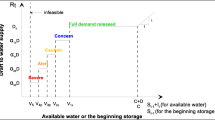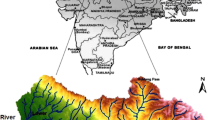Abstract
Considering the periodical changes in stream flow, it is essential to use rule curves for the optimal operation of reservoirs. This study aims to investigate the performance of Zarrineh Rud reservoir by implementing strategies for adaptation to climate change. Daily meteorological and hydrometric data were collected from selected stations upstream of the dam over a 26-year period (1990–2016). Using sequent peak algorithm (SPA) and with respect to the drinking and agricultural water demand, the active storage and its rule curve were simulated. Then, the optimal rule curve was procured through GA-SPA, aiming to minimize the downstream water shortage. The future climate data were downscaled using SDSM based on CanEsm2 model and under RCP2.6 and RCP8.5 scenarios for near (2020–2038), middle (2039–2058), and far (2059–2076) future periods. Then, the rainfall-runoff of HBV-light model was employed to calculate reservoir inflow for the mentioned periods. Finally, in view of environmental demand, reservoir performance indices were calculated for both non-adaptive and adaptive (static and dynamic hedging rules) policies. Results showed a significant decrease in the annual reservoir inflow compared to the baseline for all future periods. The least decrease was observed in RCP2.6 (nearly 23%) for the near future, whereas the largest decrease was in RCP8 (39%) for the middle period. Simulation with the static hedging rules managed to significantly reduce the average vulnerability index (by 60%) compared to no hedging, while the dynamic hedging rules outperformed static hedging rules only by 9%. Therefore, considering the insignificant improvement in reservoir performance using dynamic rules and their complexity, static hedging rules are recommended as the better option for adaptation during climate change.
Similar content being viewed by others
Availability of data and material
Available on request.
Code availability
The software used in this research will be available (by the corresponding author), upon reasonable request.
References
Abebe N, Ogden FL, Pradhan NR (2010) Sensitivity and uncertainty analysis of the conceptual HBV rain-fall–runoff model: implications for parameter estimation. J Hydrol 389(3–4):301–310
Adeloye A, Dau QV (2019) Hedging as an adaptive measure for climate change induced water shortage at the Pong reservoir in the Indus Basin Beas River, India. Sci Total Environ 687:554–566
Adeloye AJ, Montaseri M, Garman C (2001) Curing the misbehaviour of reservoir capacity statistics by controlling shortfall during failures using the modified sequent peak algorithm. Water Resour Res 37(1):73–82
Adeloye AJ, Nawaz NR, Bellerby TJ (2013) Modelling the impact of climate change on water systems and implications for decision makers. Chapter 11. In: Surampali RY, et al (eds) Climate Change Modelling, Mitigation, and Adaptation. Environmental & Water Resources Institute, ASCE, pp 299–326
Adeloye AJ, Soundharajan BS, Ojha CSP, Remesan R (2016) Effect of hedging-integrated rule curves on the performance of the pong reservoir (India) during scenario-neutral climate change perturbations. J Water Res 30(2):445–470
Ahmadzadeh H, Morid S, Delavar M, Srinivasan R (2016) Using the SWAT model to assess the impacts of changing irrigation from surface to pressurized systems on water productivity and water saving in the Zarrineh Rud catchment. Agric Water Manag 175:15–28
Alimohammadi H, Massah Bavani A, Roozbahani A (2020) Mitigating the impacts of climate change on the performance of multi-purpose reservoirs by changing the operation policy from SOP to MLDR. Water Resour Manag 34:1495–1516
Anvari S, Mousavi SJ, Morid S (2017) Stochastic dynamic programming-based approach for optimal irrigation scheduling under restricted water availability conditions. Irrig Drain 66(4):492–500
Anvari S, Kim JH, Moghaddasi M (2019) The role of meteorological and hydrological uncertainties in the performance of optimal water allocation approaches. Irrig Drain 68(2):342–353
Bergström S (1976) Development and application of a conceptual runoff model for Scandinavian catchments, Bulletin Series A, No. 52 – SMHI report RH07, Norrköping: Swedish Meteorological and Hydrological Institute, 134
Bergström S (1995) The HBV model. In: Singh VP (ed) Computer models of watershed hydrology. Water Resources Publication, Highlands Ranch, pp 443–476
Bhatia N, Srivastav R, Srinivasan K (2018) Season-dependent hedging policies for reservoir operation – a comparison study. Water 10(10):1311
Castillo O, Melin P, Pedrycz W, Kacprzyk J (2014) Recent advances on hybrid approaches for designing intelligent systems, Part of the Studies in Computational Intelligence book series (SCI, volume 547). Springer, Tijuana
Chang J, Gue A, Wang Y, Ha Y, Zhang R, Xue L, Tu Z (2019) Reservoir operations to mitigate drought effects with a hedging policy triggered by the drought prevention limiting water level. Water Resour Res 55:904–922
Chen L, Mcphee J, Yeh WWG (2007) A diversified multi-objective GA for optimizing reservoir rule curves. Adv Water Resour 30(5):1082–1093
Compos JNB (2010) Modeling the yield–evaporation–spill in the reservoir storage process: the regulation triangle diagram. Water Resour Manage 24:3487–3511
Ehteram M, Mousavi SF, Karami H, Farzin S, Singh VP, Chau K-W et al (2018) Reservoir operation based on evolutionary algorithms and multi-criteria decision-making under climate change and uncertainty. J Hydroinf 20(2):332–355
Eum H, Kim Y, Palmer R (2011) Optimal drought management using sampling stochastic dynamic programming with a hedging rule. J Water Resour Plan Manag 137(1):113–122
Fowler HJ, Kilsby CG, Connell PEO (2003) Modeling the impacts of climatic change and variability on the reliability, resilience and vulnerability of a water resource system. Water Resour Res 39(8)
Goldberg D (1998) Genetic algorithm in search, optimization and machine learning. Addison Wesley publishing compane Inc, Boston
Guo SL, Zhang HG, Chen H (2004) A reservoir flood forecasting and control System for China. J Hydrol Sci 49(6):959–972
Hashimoto T, Stedinger JR, Loucks DP (1982) Reliability, resiliency, and vulnerability criteria for water-resource system performance evaluation. Water Resour Manag 18:14–20
Hassan Z, Shamsudin S, Harun S (2014) Application of SDSM and LARS-WG for simulating and downscaling of rainfall and temperature. Theor Appl Climatol 116(1–2):243–257
Hernández-Bedolla J, Solera A, Paredes-Arquiola J, Pedro-Monzonís M, Andreu JS (2017) Sánchez-Quispe The assessment of sustainability indexes and climate change impacts on integrated water resource management. Water 9(3):213
IPCC (2007) Summary for policymakers. Climate change 2007: the physical science basis. Contribution of the Working Group I to the Fourth Assessment Report of the Intergovernmental Panel on Climate Change. Cambridge University
Jain SK (2010) Investigating the behavior of statistical indices for performance assessment of a reservoir. J Hydrol 391:90–96
Kacprzyk J (2006) Studies in computational intelligence. Polish Academy of Sciences, Warsaw
Kermani AH, Babazadeh H, Porhemmat J, Sarai-Tabrizi M (2020) An uncertainty assessment of reservoir system performance indices under the climate change effect. Ain Shams Eng J 11(4):889–904
Li L, Xu H, Chen X (2009) Streamflow forecast and reservoir operation performance assessment under climate change. Water Resour Manag 24(1):83–104
Liu L, Liu Z, Ren X, Fischer T, Xu Y (2011) Hydrological impacts of climate change in the Yellow River Basin for the 21st century using hydrological model and statistical downscaling model. Quatern Int 244(2):211–220
McMahon TA, Adeloye AJ (2005) Water resources yield. Water Resources Publications, Littleton
Moghaddasi M, Araghinejad S, Morid S (2010) Long-term operation of irrigation dams considering variable demands: case study of Zayandeh-rud reservoir. Iran J Irrig Drain Eng 136(5):309–316
Mushtaq S, Moghaddasi M (2011) Evaluating the potentials of deficit irrigation as an adaptive response to climate change and environmental demand. Environ Sci Policy 14(8):1139–1150
Normand S, Konz M, Merz J (2010) An application of the HBV model to the Tamor Basin in East-ern Nepal. J Hydrol Meteorol 7(1):49–58
Nawaz NR, Adeloye AJ (2006) Monte Carlo assessment of sampling uncertainty of climate change impacts on water resources yield in Yorkshire, England. Clim Chang 78(2):257–292
Pretto PB, Chiew FHS, McMahon TA, Vogel RM, Stedinger JR (1997) The (mis)behavior of behavior analysis storage estimates. Water Resour Res 33(4):703–709
Prasanchum H, Kangrang A (2017) Optimal reservoir rule curves under climatic and land use changes for Lampao Dam using Genetic Algorithm. KSCE J Civ Eng 22(1):351–364
Raje D, Mujumdar P (2010) Reservoir performance under uncertainty in hydrologic impacts of climate change. Adv Water Resour 33(3):312–326
Ripple W (1883) Capacity of storage reservoirs for water supply, In Minutes of the Proceedings of the Institution of Civil Engineers. Thomas Telford-ICE Virtual Library, 71, 270–278
Sandoval-Solis S, McKinney D, Loucks D (2011) Sustainability index for water resources planning and management. J Water Resour Plan Manag 137:381–390
Seibert J (1997) Estimation of parameter uncertainty in the HBV model. Nord Hydrol 28(4/5):247–262
Seibert J (2000) Multi-criteria calibration of a conceptual runoff model using a genetic algorithm. Hydrol Earth Syst Sci 4(2):215–224
Seibert J, Vis MJP (2012) Teaching hydrological modeling with a user-friendly catchment-runoff-model software package. Hydrol Earth Syst Sci 16(9):3315–3325
Soundharajan BS, Adeloye AJ, Remesan R (2016) Evaluating the variability in surface water reservoir planning characteristics during climate change impacts assessment. J Hydrol 538(10):625–639
Srinivasan K, Kumar K (2018) Multi-objective simulation-optimization model for long-term reservoir operation using piecewise linear hedging rule. Water Resour Manag 32(2):1901–1911
Traynham L, Palmer R, Polebitski A (2011) Impacts of future climate conditions and forecasted population growth on water supply systems in the Puget Sound Region. J Water Resour Plan Manag 137(4):318–326
Tu MY, Hsu NS, Tsai FTC, Yeh WWG (2008) Optimization of hedging rules for reservoir operations. J Water Resour Plan Manag 134(1):3–13
Wilby RL, Dawson CW, Barrow EM (2002) SDSM a decision support tool for the assessment of regional climate change impacts. Environ Model Softw 17(2):145–157
Yeh JY, Lin WS (2007) Using simulation technique and genetic algorithm to improve the quality care of a hospital emergency department. Expert Syst Appl 32(4):1073–1083
Yin XA, Mao XF, Pan BZ, Zhao YW (2015) Suitable range of reservoir storage capacities for environmental flow provision. Ecol Eng 76:122–129
Author information
Authors and Affiliations
Contributions
M.M & S.A.: Conceptualization, methodology, technical investigation, writing, reviewing and editing, visualization, supervision, software, data curation, validation, editing; N.A.: writing, original draft preparation.
Corresponding author
Ethics declarations
Ethics approval
Not applicable because this article does not contain any studies with human or animal subjects.
Consent to participate
The research data were not prepared through a questionnaire.
Consent for publication
There is no conflict of interest regarding the publication of this article.
Conflict of interest
The authors declare no conflict of interests.
Additional information
Publisher's Note
Springer Nature remains neutral with regard to jurisdictional claims in published maps and institutional affiliations.
Rights and permissions
About this article
Cite this article
Moghaddasi, M., Anvari, S. & Akhondi, N. A trade-off analysis of adaptive and non-adaptive future optimized rule curves based on simulation algorithm and hedging rules. Theor Appl Climatol 148, 65–78 (2022). https://doi.org/10.1007/s00704-022-03930-y
Received:
Accepted:
Published:
Issue Date:
DOI: https://doi.org/10.1007/s00704-022-03930-y













